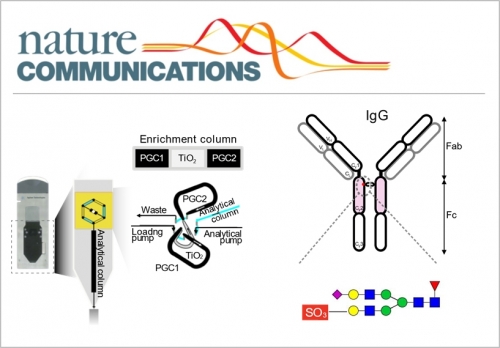Significant breakthrough made in glycomic research
M.U.S.T. identified new biomarkers for rheumatoid arthritis

TiO2-PGC chip
The State Key Laboratory of Quality Research in Chinese Medicine (Macau University of Science and Technology) research team, successfully designed the world’s first TiO2-PGC chip, whose highly sensitive analytic techniques enables detection of subtle variations of glycan trace in the complexity of glycosylation. The research finding has been a major breakthrough in glycomic research and diagnosis of rheumatoid arthritis, and has provided a great technological platform for in-depth glycomic studies and for screening Chinese medicine elements with immunomodulation functions.
A research paper on glycomic studies and rheumatoid arthritis titled “A method to identify trace sulfated IgG N-glycans as biomarkers for rheumatoid arthritis” was published in the world famous comprehensive journal Nature Communications of the “Nature Publishing Group” on September 20, 2017. Nature Communications mainly publishes high-quality research papers in biology, physics and chemistry; its impact factor as announced in 2017 is 12.12. This has been the first journal paper published in Nature Communications that takes a Macao research institution as the first-author affiliation institution and the corresponding institution, which greatly demonstrates the overall strengths of M.U.S.T. in glycomics.
Immediately subsequent to the publication of the paper, the international scholarly community has given high attention to the research. Editor of another international journal, Nature Reviews Rheumatology (impact factor: 12.18), selected and introduced the paper as a research highlight, concluding that the TiO2-PGC chip solved the global technical problem that detection of low-abundance IgG acidic glycans in autoimmune diseases such as rheumatoid arthritis had been extremely hard, and that the two newly discovered sulfated IgG N-glycans would have a promising applied future.
The research project was sponsored by the Macao Science and Technology Development Fund. Chair Professor Jiang Zhi Hong and Chair Professor Liu Liang from the State Key Laboratory of Quality Research in Chinese Medicine served as the corresponding authors; Associate Professor Wang Jing Rong of the State Key Lab was the first author; Professor Liang Yong from the Faculty of Information Technology, doctoral students of the State Key Lab, Gao Wei Na (graduated) and Meng Qiong, and researchers of the State Key Lab, Yau Lee Fong, Tong Tian Tian, and Huang Hao, were the co-authors.

Diagram of the specialized TiO2-PGC chip (left) and structural maps of N-glycans on IgG (right)





